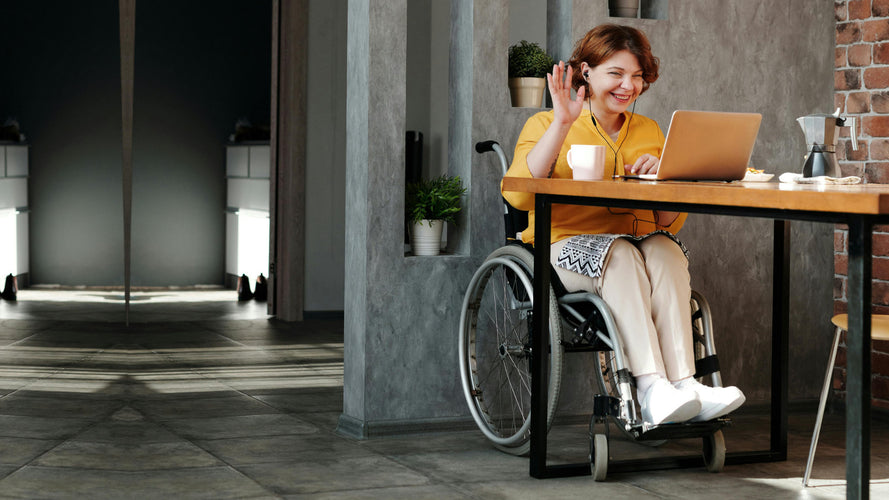Orders over £100

Wheelchair Width: How Wide Does a Doorway Need to Be for A Wheelchair?
Whether you use a wheelchair yourself or want to make your home or business more accessible for others, knowing how wide a doorway needs to be for wheelchair access is crucial. Even those who use rollators and walkers can benefit from wider doorways, but how wide is wide enough?
The best wheelchairs can range in width from 530mm (21 inches) to 1010mm (40 inches), depending on their use. To be more accessible, it’s best to have doorways wide enough for everyone to use, no matter how wide their wheelchair is. However, there’s more to consider than just the wheelchair’s width, with surrounding space and movement method also important.
How Wide is a Wheelchair?
Before discussing how wide a door needs to be to fit a wheelchair, it’s first helpful to know the different wheelchair sizes.
Just like there are many different types of mobility aids (e.g., wheelchairs, walkers, canes, etc.), there are also varieties within these categories. By this, we mean that there are several types of wheelchairs, not just one type that everyone who needs a wheelchair uses. These different types serve unique purposes, which can also cause their widths to vary.
For example, there’s the standard wheelchair; it can be pushed by someone else, or the user can wheel themselves. These wheelchairs generally range in width from 635mm (25 inches) to 915mm (36 inches). Another type of wheelchair is the power wheelchair, which starts at a width of 585mm (23 inches) but can be as wide as 810mm (32 inches).
The Tires Matter
With wheelchairs, measurements must be made from tire to tire, not just the seat the user is sitting in or the handlebars used to push the wheelchair. Depending on the tire type used, this can add considerable width to the chair. For instance, a large rear wheel tire adds 230mm (9 inches) to the seat’s width, so a 455mm (18 inches) wide seat would equate to a 685mm (27 inches) wheelchair width.
Transport wheelchairs generally have tires that add only 130mm (5 inches) to the seat width. Since these wheelchairs are used only temporarily, they do not need the larger tires that wheelchairs intended for daily use need.
Other Wheelchair Factors Affecting Width
Certain components of a wheelchair can affect the amount of open space it needs surrounding it. For instance, some wheelchairs have reclining backrests or elevated leg rests, which require more room when rotating and manoeuvring through the space.
The wheelchair width also depends on how the wheelchair is used. Power wheelchairs allow the user to keep their arms tucked in, but manual wheelchairs, if manoeuvred by the user, require more space when going through a doorway because of the user’s hands and arms. The doorway must be wide enough for them to wheel themselves through without their arms becoming stuck between the wheelchair and doorframe.
In general, the standard wheelchair width while occupied is 635mm (25 inches), but additional space is needed on either side for the user to propel it manually or situate themselves into position.
How Wide Should a Doorway Be for A Wheelchair?
Knowing how many types of wheelchairs there are, it’s important that doorways are wide enough to comfortably allow access for all types of wheelchairs, especially in places of business where a range of clients may come in. For those looking to find the best doorway width for their home, the only priority is that your wheelchair can easily pass through, meaning it may not have to be as wide.
As for how wide a doorway needs to be for a wheelchair, UK Legislation states that the principal communal entrance of a building must have a door with a clear opening width of at least 775mm (30.5 inches). However, it’s generally recommended that the door opening be 900mm wide (35 inches), and a 1000mm (39 inches) width is even more ideal.
Furthermore, there should be a minimum of 300mm between the opening edge of the door and the nearest side obstruction, such as a wall. This ensures that those in wheelchairs have enough room to open the door and stay out of its swing path.
Things to Consider with Disability Door Width
When determining the width of your wheelchair-accessible door, you need to consider more than just the width of a wheelchair.
How The Door Will Be Approached
How wheelchair users approach a door may require extra width in the doorframe. For example, if there’s room before the door frame that will allow them to head straight through, they won’t need any additional width, while if there is no room for manoeuvring and the wheelchair user has to go in at an angle, they will need more room.
Don’t forget to consider this from both sides, whether they’re going in or out of the door.
The Landscape After Passing Through the Door
It’s not just the leadup to the door frame that you must consider; you also have to think of what needs to be done after passing through the door. For example, will the wheelchair user have to turn or manoeuvre immediately, and is there room for them to do that if they have to go through the door frame straight? If not, they may need a wider door.
The Level of Access
When possible, access to a property should be level. However, if ramped access is necessary, the gradient should be no steeper than 1:20, as this is easier for those in wheelchairs to manoeuvre. Just like the doorframe, the ramp should also be of a certain width, with minimum requirements being 1000mm. Ramps should also be level directly in front of the door to help those in wheelchairs get through the door.
Depending on the angle of the ramp, a wider door may be necessary.
Other Tips for Making a Home Wheelchair Accessible
If you’re new to using a wheelchair, the following tips can help make your home more wheelchair accessible.
Use Offset Hinges
Offset hinges, also known as Z hinges, allow the door to swing clear of the doorway, leaving more room for the wheelchair to pass. It might not seem like a hinge can do much, but it can add around an inch of clearance, and this extra inch of space may be the difference between needing to widen the door frame or leaving it as is.
Remove Doors or Trim
In addition to changing out the hinges, you may find it easiest to remove the door entirely, offering you more clearance. If you need more space, you can also remove the door trim, opening up the passageway even more.
Add A Ramp
It’s not just the doorframe width that needs to be considered, but also the ease of passing through the door from the floor standpoint.
If the doorframe has a threshold or lip that breaks up the flooring, a small ramp to ease this transition can make it considerably easier to pass through the doorframe.
Remove Carpet and Rugs
While they can add a certain level of coziness to an environment, carpet and area rugs can be challenging to manoeuvre a wheelchair over. If possible, try to remove these and replace them with smoother options, such as tiles, hardwood flooring, laminate, or vinyl.
Creating Wheelchair Accessible Homes and Businesses
When it comes to putting in a wheelchair-accessible door, whether in a personal dwelling or place of business, some important factors must be considered.
With wheelchairs coming in a range of styles and sizes, the minimum width that a doorway should be in order to be wheelchair accessible is 775mm (30.5 inches), although widths between 900–1000mm (35–39 inches) are more ideal as they are easier for individuals in wheelchairs to pass through. Additionally, these larger widths support locations where an individual may not be able to pass through the doorway straight.
In addition to widening doorframes, other ways to make your home more wheelchair accessible include smoothing transitions, swapping the hinge on the door, and removing carpet or area rugs.
Check out our best wheelchairs and their different sizes to see the variety available for wheelchair users.
About the Author

Jessica Guht
Jessica is a freelance medical writer with a Master's degree in Biomedical Engineering.
Learn more about the author on Jessica's website.
